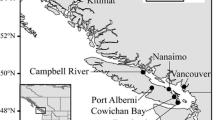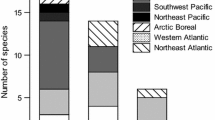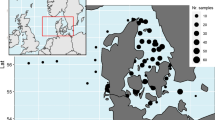Abstract
Most studies characterizing successful biological invaders emphasize those traits that help a species establish a new population. Invasions are, however, multi-phase processes with at least two phases, dispersal and introduction, that occur before establishment. Characteristics that enhance survival at any of these three phases will contribute to invasion success. Here, we synthesize information on the dispersal, introduction, and establishment of fishes mediated by ship ballast-water transport. We synthesize 54 reports of at least 31 fish species collected from ballast tanks (Phase 1), including 28 new reports from our recent studies (1986 to 1996). Our literature survey revealed 40 reports of 32 fish species whose introductions have been attributed to ballast transport (Phase 2), of which at least 24 survived to establish persistent populations (Phase 3). We detected little overlap at the species level between these two data sets (Phase 1 vs Phases 2 and 3), but patterns emerged at the family level. The Gobiidae (6 species), Clupeidae (4 species), and Gasterosteidae (1 species) were the most commonly found fish families in ballast tanks (Phase 1). The Gobiidae (13 species), Blenniidae (6 species) and Pleuronectidae (2 species) dominated the list of ballast-mediated introductions (Phase 2); gobies and blennies were the families most frequently established (Phase 3). The invasive success of gobies and blennies may be explained in part by their crevicolous nature: both groups seek refuge and lay eggs in small holes, and may take advantage of the ballast-intake holes on ship hulls. This behavior, not typically associated with invasive ability, may contribute to successful introduction and establishment by facilitating the dispersal phase of invasion. The failure of the pleuronectids to invade may reflect poor salinity match between donor and recipient regions. To develop a predictive framework of invasion success, organisms must be sampled at all three phases of the invasion process. Our comparison of two ballast sampling methods suggests that fishes have been undersampled in ballast-water studies, including our own, and that the role of ballast transport in promoting fish invasions has been underestimated.
Similar content being viewed by others
Author information
Authors and Affiliations
Additional information
Received: 13 January 1999 / Accepted: 24 February 2000
Rights and permissions
About this article
Cite this article
Wonham, M., Carlton, J., Ruiz, G. et al. Fish and ships: relating dispersal frequency to success in biological invasions. Marine Biology 136, 1111–1121 (2000). https://doi.org/10.1007/s002270000303
Issue Date:
DOI: https://doi.org/10.1007/s002270000303




